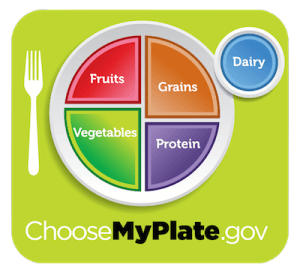Lesson Overview
This lesson helps young people understand the importance of accurately estimating how much of a food they should eat. The youth will estimate portion sizes of snacks and compare to the actual serving size. To make estimating easier, they will compare portion sizes to common items.
Introduction
To introduce this topic, share the following information with the youth. If desired, you can reference the Nutrition Facts label on this handout.
- Average portion sizes of food and beverages in America have significantly increased over the past 20 years. Often the portion size of food and/or drink we have is enough for two or three people. This increase in portion size is changing what we think of as a “normal” portion.
- A portion is the amount of food that you choose to eat for a meal or snack.
- A serving is a measured amount of food or drink, such as one slice of bread or 1 cup (eight ounces) of milk.
- Many foods that come as a single portion actually have multiple servings. The Nutrition Facts label on packaged foods—found on the backs of cans, sides of boxes, etc. — tells you the number of servings in the container.
- It is important for young people to understand that this distortion of portion sizes is causing us to think we can eat more of certain foods than our bodies truly need which can lead to being overweight or obese and an increased risk for chronic (long-lasting) disease.
Activity: What’s your portion size?
For this activity you will need a full bag of chips or box of snack crackers and two paper plates.
Any young person or instructor handling food should wash their hands prior to handling the food.
- On one plate, ask a volunteer to pour out the amount of snack they think one serving would be.
- Next, have him or her look at the Nutrition Facts label on the package. It tells you how many servings are in the package and what amount equals one serving size. Have the volunteer take out one serving size and put it on the other plate next to the plate with the serving size he or she thought might be one serving.
- Ask the youth to compare the two, and let them share their thoughts about it.
- What happens if we are always eating portions that are more than one serving and we start to think that a bigger portion of food is “normal?” Give the group time to answer. If we eat portions on a regular basis that are larger than our body requires we may gain excess weight or become unhealthy.
- Give a few examples of portion distortion:
- A single serving of pretzels is 10 pieces, however many people will eat twice as many without realizing they’re eating a double portion.
- Many brand name cereals list a portion as ¾ or 1 cup. If you were to pour out ¾ cup of cereal it would look rather small, especially if you use a typical cereal bowl.
Understanding portion sizes is an important component to maintaining a healthy lifestyle.
Activity: Estimating Accurate Portions
- Show young people the Portion Distortion Slides/Quiz-Interactive Web Application.
- Ask them, what are some ways we can keep our portions within a single serving size? Possible answers might be:
- Don’t eat snacks like chips or cookies right from the bag. Instead, put one serving size on our plate, close the bag, and put it away.
- Look at the Nutrition Facts labels on foods more often so we know the actual serving size.
- Review the importance of understanding what is an acceptable portion size of the food they are eating.
Serving sizes are listed on the labels of most foods, so use the Nutrition Facts label to decide the amount that is right for you. For foods that don’t have a label, common items can be your guide to help you decide the right portion.
- Deck of cards = 3 ounce serving of meat/protein
- Tennis ball = serving of fruit or 1/2 cup ice cream
- Fist = 1 cup serving vegetables and grains
- Tip of thumb = dressings, butter or cream cheese
- 4 dice = 1 ounce of cheese
If time permits, use the ChooseMyPlate.gov Food Gallery to come up with your own comparison of portion size to common objects.
Conclusion
Have young people write down the most surprising thing they learned about portion sizes today and post it on a visible area in the classroom or take home to post on their refrigerator.
Continuing the Conversation
Hand out the Healthy Families Newsletter in English or Spanish, so that young people can continue discussing healthy portion sizes with their families at home.
Related Health Powered Kids Blog
Portion sizes: What amount is ‘right’?


